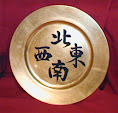For those who are not on FarceBook, I am copying here the post that Shannon Appelcline has shared yesterday on the “Glorantha Fans” group: a listing of the Aldryami’s spirits/songs/themes/gods. Missing: heroes and some of the Iri fragments.
Dramatis Prosopaedia: The Grower
- Potential. The unworshipped potential of the universe.
The First Planting
- The Grower. Potential reborn as the unworshipped creator of all things.
The Second Planting
- Eron. The healing waters. A piece of the Grower, and one of the Protectors.
- Gata. The broken earth. A piece of the Grower, and one of the Protectors.
- Halamalao. The warm sun. A piece of the Grower, and one of the Protectors.
- Falamal. The Grower reborn in the world, father of all plants.
The Pure Seeding
- Aldrya. The first seed planted in Gata.
- Haldrya. The first seed planted in Halamalao.
- Murthdraya. The first seed planted in Eron.
- Seyotel. The song that connects all life.
The Sundering of Seyotel
- Eirennor. The first Seer: Aldryami perception.
- Larayse. The first Mover: Aldryami mobility.
- Trileme. The first Doer: Aldryami action.
The Third Planting
- Bengara. Death-to-live, the power to prune, the Grower reborn to embody the Balance.
- Veratha. Life-after-life, rebirth, the Grower reborn to embody the Cycle.
The Hybrid Seeding
- Mee Vorala. The first plant grown in Trigora, a life in death.
- Slor. The first spore, equal parts life and death.
Dramatis Prosopaedia: The Taker
The First Planting
- The Taker. Potential reborn as the unworshipped destroyer of all things.
The Second Planting
- Ekeem. The sterile stone. A piece of the Taker, and one of the Pretenders.
- Iri. The enshrouding dust. A piece of the Taker, and one of the Pretenders.
- Zasara. The dark sun. A piece of the Taker, and one of the Pretenders.
- Bebester. The unworshipped Taker reborn in the world, the great pruner.
The Sundering of Iri
- Iniri. The freezing snow. A fragment of Iri, and a lesser Pretender.
- Kitipah. The burning flame. A fragment of Iri, and a lesser Pretender.
The Third Planting
- Ferotha. Live-to-die, natural death, the Taker reborn to embody the Cycle.
- Trigora. Death-after-death, the Underworld, the Taker reborn to upset the Balance.
The post was followed by a Q&A:
Q: Which of these survived the Darkness? Which are still worshipped?
A: The Protectors are all wounded: Halamalao isn’t as bright (and isn’t at the top of the Sky Dome), Gata is broken into thousands of pieces; and Eron has definitely been damaged, but different myths give different descriptions of that (he took some fire into himself, he wept, he bled, he gave control of the oceans to Magasta).
Haldrya is lost, along with all the white elves.
As for “survived”, that’s a funny question, because Glorantha and Trigora (the Underworld) are just two parts of the Cycle. I know that at least one of the “spiritual songs” dwells in Trigora. Maybe Larayse. But that doesn’t stop Aldryami from communicating with him/her/it. (Technically, all three of the spiritual songs died, because they were normal plants that developed the ability to sense, to move, and to act, but I don’t know if they're all still in Trigora or not.)
And there’s certainly been a lot of movement between the Underworld and Glorantha: all of the Mreli and all of the Makisanti for a start. And there have definitely been rumours and prophecies that the Vronkali who were planted during Aldrya’s Woe will be returning.
Oh, and worshipped? The vast majority of Aldryami worship Aldrya (or Murthdrya). After that, small minorities probably follow Falamal, Eron, Halamalao, and Gata. Then Bengara and Veratha. There are also some very few ‘dark’ elves who follow Ekeem, Iri, and Zasara. The others (the “spiritual songs” in the top triangle) are more abstractions and powers.








